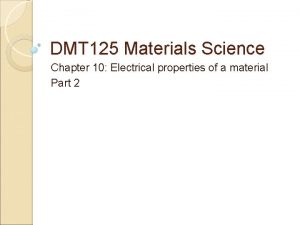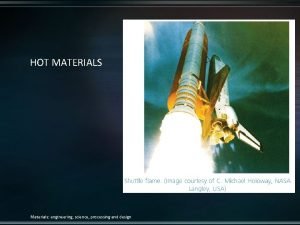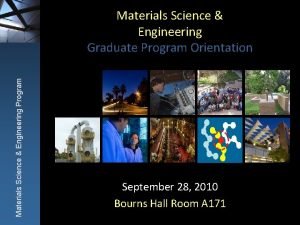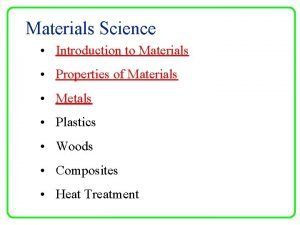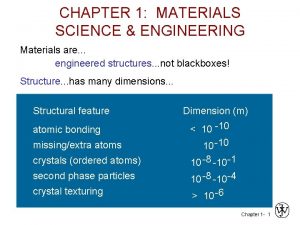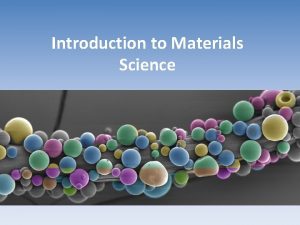Chapter 1 Introduction Materials Science and Engineering Materials








- Slides: 8

Chapter 1: Introduction

Materials Science and Engineering �Materials science: investigating the relationships that exist between the structures and properties of materials �Materials engineering: is designing or engineering the structure of a material to produce a predetermined set of properties on the basis of these structure-property correlations �Structure of a material: arrangemnet of its internal components. � Subatomic: involves electrons within individual atoms and interactions with their nuclei � Atomic: organization of atoms or molecules relative to one another � Microscopic: large groups of atoms that are normally agglomerated together � Structural elements (macroscopic)

Materials Science and Engineering �A property: a material trait in terms of the kind and magnitude in response to a specific imposed stimulus. � Definition of properties are made independent of materials shape and size �Properties of solid materials are grouped in six catageries: 1. 2. 3. 4. 5. 6. Mechanical: deformation to applied load (elastic modulus) Electrical: electric field stimulus (electric conductivity) Thermal: thermal conductivity Magnetic: response of material to magnetic field Optical: stimulus is electromagnetic or light radiation (index of refraction) Deteriorative: chemical reactivity of materials �Processing �Performance �Interrelationship between processing, structure, properties, and performance is linear

Why study materials science and engineering �Exposer to design problems involving materials �A material problem is one of selecting the right material based on several crietria: �In-service conditions : trade-off �Deterioration during service : high temp, corrosive environment. �The more familiar an engineer is with various char and structure-property relationships, as well as processing techniques, the more proficient and confidednt he will be to make reasonable choices.

Classification of materials 1. Metals: large numbers of nonlocalized electrons (not bound to particular atoms). � � � 2. Ceramics: compounds between metalic and non-metalic elements, oxides, nitrides, and carbides. � � � 3. Very large molecular structures. Low densities, extremely flexible. Composites: more than one material type. Fiberglass, concrete Semiconductors: electrical properties that are intermediate between conductors and insulators. � 6. Poor conductor of heat and electricity. Resistant to high temp and harsh environment. Hard and very brittle Polymers: plastic and rubber. Organic compounds that are chemically based on carbon, hydrogen, and other nonmetalic elements. � � 4. 5. Extremely good conductors of heat and electricity. Not transparent to visible light. Lustrous appearance. Strong and deformable Extremely sensitive to to the presence of minute concentrations of impurity atoms Biomaterials: compounds implanted into human body. � Must not produce toxic substances. Must be compatable with body tissues

Materials of the future � Smart Materials: able to sense changes in their environments and then respond to these changes in predetermined mannars – traits that are also found in living organisms. � Components of a smart material include some type of sensor and an actuator � A sensor: detects an input signal � Actuator performs a responsive and adaptive function � Actuators may be called upon to change shape, position, natural frequency, or mechanical characterstics in response to changes in temp, electric fields, and/or magnetic fields � 4 types of materials are commonly used for actuators: 1. Shape memory alloys: metals that after having been deformed, revert back to their original shapes when temp is changed 2. Piezoelectic ceramics: expand contract in response to an applied electric field or voltage. They also generate an electric field when their dimensions are altered 3. Magnetostrictive materials: an aleogeous to piezoelectric except that are responsive to magnetic fields 4. Electroheological/ Magnetoheological fluids: liquids that experience dramatic changes in viscosity upon the application of electric and magnetic fields. � Materials/devices employed in sensors include optical fibers, piezoelectric materials,

Nanotechnology �Top-down approach: study large and complex structures, and then investigate the fundamental building blocks of these structures that are smaller and simpler �Bottom-up: manipulate and move atoms and molecules to form new structures and thus design new materials that are built from simple atomic level constitutents. This ability to curefully arrange atoms provide opportinities to develop mechanical, electrical, magnetic, and other properties that are not otherwise possible. �Nanotechnogy: Bottom-up approach and the study of the properties of materials at a scale of less than 100 nm (500 atoms)

Modern materials needs �Enviromental impact �Weight reduction �Increase operating temp �New high strength and low density �New economical sources of energy �Use present resources more efficiently �None-renewable resources: discovery of additional reserves. Development of new materials. �Recycling
 Introduction to materials science for engineers chapter 10
Introduction to materials science for engineers chapter 10 Introduction to materials science for engineers chapter 10
Introduction to materials science for engineers chapter 10 Materials engineering science processing and design
Materials engineering science processing and design Iit delhi material science faculty
Iit delhi material science faculty Science fusion introduction to science and technology
Science fusion introduction to science and technology What's your favourite lesson?
What's your favourite lesson? Chapter 1 intro to forensic science
Chapter 1 intro to forensic science Engineering science chapter 3
Engineering science chapter 3 Engineering science 1
Engineering science 1

